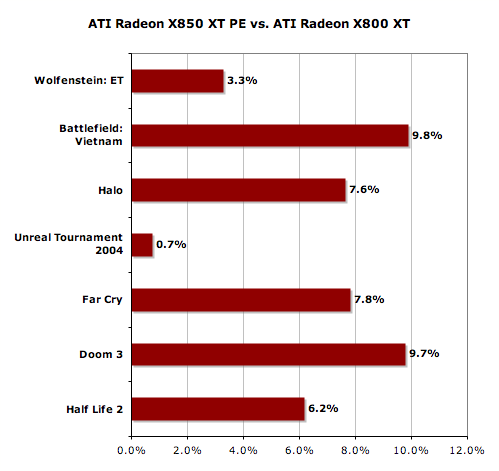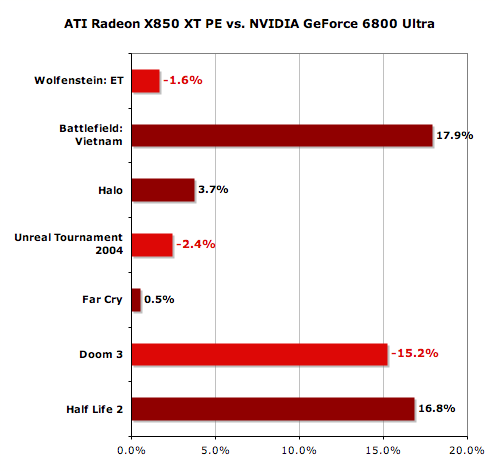ATI's New Radeon X850 and X800 Lines: A Smorgasbord of GPUs
by Anand Lal Shimpi & Derek Wilson on December 1, 2004 9:41 AM EST- Posted in
- GPUs
ATI's Radeon X850 XT Platinum Edition
Compared to the X800 XT:
Compared to ATI's previous flagship, the X850 XT PE offers a 0 - 10% increase in performance, with the biggest gains coming in Battlefield and Doom 3. The performance improvements aren't negligible, but definitely no reason to upgrade from a X800 XT. If you're stuck choosing between the two, what's another $50 when you're already spending $500 on a video card?

Compared to NVIDIA's GeForce 6800 Ultra:
Next up we have the X850 XT PE compared to NVIDIA's flagship, the GeForce 6800 Ultra, which is currently only available through OEMs in a PCI Express version.

ATI has always done better in Battlefield than NVIDIA has, so it's no surprise to see the X850 XT PE with a huge advantage there. The rest of the games are basically a wash with the exception of Doom 3 and Half Life 2. Under Doom 3, the X850 XT PE is about 15% slower than the GeForce 6800 Ultra, but the tables are turned as soon as you look at Half Life 2, where the X850 XT PE is almost 17% faster than the GeForce 6800 Ultra. So which card do you pick? Well, both happen to run every single game out on the market just fine at the highest resolutions/detail settings so you can't really go wrong either way. The issue here is predicting whether more developers will use Valve's Source engine or id's Doom 3 engine for future games, and at this point that's a tough prediction to make.
The Radeon X850 XT Platinum Edition basically offers smoother playability at 1600 x 1200 in all of today's games (including Half Life 2 and Doom 3) than either of the previous reigning champions, the X800 XT and the GeForce 6800 Ultra. Now let's have a look at the rest of the X850 line...










69 Comments
View All Comments
WSquared - Wednesday, December 1, 2004 - link
The article says: "Unfortunately, we haven't located any 12-pipe NVIDIA GeForce 6800 PCI Express solutions...There's one in the UK here:
http://www.overclockers.co.uk/acatalog/copy_of_680...
Look for the "OcUK GeForce 6800 GTo 256MB"
It's a strange 12 pipe card clocked at 350/900. I'm sure it could be down-clocked if required for benchmarks.
archcommus87 - Wednesday, December 1, 2004 - link
Yeah, if frickin' nForce 4 boards with PCI-E would finally come out...Man it's taking so long.
Avalon - Wednesday, December 1, 2004 - link
Keep an eye on the x800 XL. That's the interesting card of the bunch. At a $349 suggested MSRP (you know we'll shortly see deals for $300 for the card), this is a great card. It outperforms the x800 and x850 pro, costs less, and runs on a 16 pipeline architecture. If it has room to overclock, some noticeable performance gains should be there. It sounds like an awesome alternative to the 6800GT for those that are $50 short.skunkbuster - Wednesday, December 1, 2004 - link
why can't ati makde -decent- openGL drivers? they ~still~ suck when it comes to open gl games/softwareMadAd - Wednesday, December 1, 2004 - link
Anand, will you or someone at AT sometime soon please either include 1920x1200 in normal reviews, or, could you do a one off set of benchmarks with all the dx9 cards at your disposal, at 1920x1200 please?
LoneWolf15 - Wednesday, December 1, 2004 - link
#6, the Video Processing Unit is for encode AND decode. This is well documented. From NVidia's website:"Adaptable Programmable Video Processor
Video Decoding
A key element of modern-day video processing, MPEG-2 is the basis for such functions as DVD playback. Through advanced technology functions such as motion compensation and inverse discrete cosine transformation (IDCT), the GeForce 6 Series GPUs handle MPEG-2 decoding very efficiently, offloading the CPU of the heavy lifting involved in video playback. The result is smooth, high-quality video and reduced power usage.
Another important factor is that the GeForce 6 Series GPUs are completely programmable and can handle formats such as WMV9 and MPEG-4. The NVIDIA motion compensation engine can provide decompression acceleration for a variety of video formats including WMV9, MPEG-4, H.264, and DiVX. As with motion compensation for MPEG-2, the NVIDIA video engine can perform most of the computation-intensive work, leaving the easiest work to the CPU.
Video Encoding
The GeForce 6 Series GPUs are also capable of hardware video encode acceleration. Traditionally, video encoding is a difficult and time consuming process. The GeForce 6 Series GPUs include a motion estimation engine. Using state-of-the-art technologies, the motion estimation engine delivers higher-quality video at the same or lower bit rate, as well as lower CPU utilization for improved system performance."
Momental - Wednesday, December 1, 2004 - link
Part of me sees this as a brilliant marketing and test strategy for ATi. Yup. The availability of their high-end cards have been all but non-existent and who's to say this wasn't intentional? Maybe they wanted to throw out some product to see how well it sold and in which flavor (AGP or PCI-e)?Now they know and this is why we'll have no problem getting our hands on these "refreshed" cards in the next 6 to 10 weeks, if not sooner.
I'm suggesting that they merely offered cards like the X800XT PE as a "test drive" to see how well it performed and how quickly it left shelves. My hope is that they don't cripple the X800XL card, which looks to be the "sweet spot" here, because they know it performs better and costs less than the X850Pro!!
In a short while, we'll all see how their new naming convention makes perfect sense as they cull out the "older" cards and make the newer refreshed ones their "top shelf" vodkas. ;)
Noli - Wednesday, December 1, 2004 - link
The X800 XL gives you 16 pipes for $350 on a 0.11 micron chip. With such a small fan (must be cool?) and low core/mem, *if* it overclocks well it could be a blinder and out-do 6800GT for value just below the top of the range cards. I'll be keen to see how it does. Big if though for the moment...archcommus87 - Wednesday, December 1, 2004 - link
I couldn't agree more about naming the products! How can they make something so simple so difficult? Maybe someone more in touch with them like Anand themselves could give them a piece of their mind.Here's how it should be done. Each new type of card can be a new hundreds series, i.e. 100s, 200s, 300s, etc. Then the specific products can be within there. For example, low end 110, middle 150, high 190. And then if they marginally increase the clocks of the best card, make it the 195. Simple!
And I couldn't agree more on prices, too. I remember when the top of the line was $300 (never remember it being less than that). Now if you want the best you're talking almost $600. And for the best CPU? Over $1,000. Absurd. I'd never more than:
$200 for a CPU
$150 for a motherboard
$300, MAYBE $350 for a video card
$150-$200 for memory
$150 for hard drive
bigpow - Wednesday, December 1, 2004 - link
I'd like to see the 6800 in the comparison